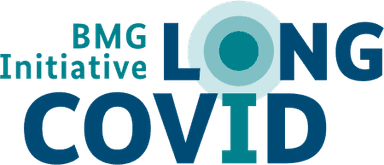Note: The following text is a guest article. They reflect the personal views of the author. The article is not an expression of opinion by the Federal Ministry of Health.
Guest Article: Katrin Kunert
This guest article by Katrin Kunert, Vice President of recreational, preventive and rehabilitation sports at the National Paralympic Committee Germany (DBS) e.V. places a focus on the holistic approach of rehabilitation exercise as a promising approach to addressing the diverse physical and psychological impairments of patients with Long COVID.
Published on 13.02.2024

© Uwe Voelkner / FOX-Fotoagentur
Rehabilitation exercise – an opportunity for patients with Long COVID
“Post-COVID outpatient clinics” provide a first port of call to those affected by the late and long-term effects of COVID-19 infection. At the end of the rehabilitation chain, rehabilitation exercise as stipulated in section 64 of Social Code Book IX provides a promising opportunity through its holistic approach to help address the diverse physical or psychological impairments of Long COVID patients.
Long COVID can exhibit many different symptoms that may emerge in isolation or in combination with others. When planning aftercare for Long COVID patients, its broad spectrum of symptoms must be taken into account. Similarly, the psychological and emotional strain on those affected due to the illness or anxieties regarding the future must also be considered, meaning that therapeutic interventions in form, for instance, of physiotherapy, ergotherapy or neuropsychological care are often unlikely to suffice. This can be exacerbated by long waiting times, for instance with psychological treatment of depression and anxiety disorders.
Optimal care can only be provided by working together
Support is provided, for instance, through newly set up “post-COVID outpatient clinics”. Ensuring these are staffed with the corresponding specialists enables multi-disciplinary exchange between physicians and therapists. This allows for a more holistic treatment. In addition to outpatient care, in-hospital rehabilitation measures are also utilised. The problem of how to ensure a seamless transition to outpatient care and continuation of what has been learned during rehabilitation measures is well-known from other sectors and also presents a challenge for people undergoing COVID-19 rehabilitation. But how can we actually provide these people with services close to their home that equally address and sustainably treat their physical and psychological symptoms? As supplementary rehabilitation services pursuant to section 64 of Social Code Book IX, medically prescribed rehabilitation exercise can make an important difference.
Rehabilitation exercise is provided by law for people with disabilities or those at risk of disabilities, and therefore provides targeted possibilities to help manage and alleviate the Long COVID syndrome. It follows a holistic approach, provides assistance with self-help and aims to improve physical and psychological symptoms, yet also takes into account social considerations. Thus, for one, rehabilitation exercise serves to improve stamina, strength, coordination and flexibility, but it also enhances one’s awareness of the body as well as relaxes and counters depressive states or fears.
Medically prescribed rehabilitation exercise is led by specially trained exercise instructors in fixed groups so as to also reap the benefit from key group-dynamic effects, specifically participation and mental stabilisation. The National Paralympic Committee Germany (DBS) is the largest association of rehabilitation exercise service providers and addresses through various training programmes the challenge of best-equipping its roughly 42,000 exercise instructors to confront the comparatively new, multifaceted syndrome in keeping with its own high quality requirements. With cases of exercise intolerance, to help avoid the dreaded crashes following physical exertion, it is important to clearly define with the patient and the prescribing doctor the training loads. Usually, this can draw on previous training loads established over the course of the rehabilitation programme. Here, pacing also plays a central role so as to manage one’s energy resources sparingly, find the optimal level of exertion and avoid overexerting those engaging in the rehabilitation exercise.
Recommendations on prescription and implementation
One essential requirement for an expedient implementation of rehabilitation exercise is correctly coding it pursuant to its ICD-10 code on Verordnungsblatt Muster 56 (prescription template 56) of the National Association of Statutory Health Insurance Physicians (KBV) or Form 850 of the German Pension Insurance (DRV). The sports club and the exercise instructors must be able to recognise from the prescription the required focus areas as well as areas of activity of the rehabilitation exercise offering in order to determine the right rehabilitation exercise group for the participants and provide them with suitable exercises. During an introductory conversation, the participants also have an opportunity to exchange ideas with the exercise instructors on their expectations and personal goals.
Using the National Association of Statutory Health Insurance Physicians’ coding guidelines, the Commission for Medicine at the DBS developed a guide to help doctors fill out such a prescription form. It is recommended to prefix the ICD-10 diagnostic code of their main impairment, e.g. dyspnoea, cardiac arrhythmia, fatigue, depression or non-specific lower back pain following extended periods of bed rest. U08.9 or U09.9 is then added as a second code. These describe conditions following a COVID-19 infection. Here it should be noted that the code U09.9 cannot be written on its own. This image illustrates the procedure.
Participation in rehabilitation exercise is recommended twice a week – in certain cases up to three times a week – in order to optimise the effect of these exercises. After taking advantage of the usually 50 training units prescribed (statutory health insurance funds), with the relevant justification of continued medical need follow-up prescriptions are possible.
In conclusion, for individuals with persisting symptoms following SARS-CoV-2 infection, it can be said that as a holistic approach toward rehabilitation, rehabilitation exercise in groups represents an effective added treatment measure to achieve goals such as Health Related Quality of Life (HRQoL) and to participate in working life and one’s social environment. This is not charged against the budget for therapeutic services. Rehabilitation exercise means receiving help towards self-help. To facilitate lifelong sports activities, after completion of the rehabilitation exercise, it is possible to make use of various other high-quality sports offers provided by the National Paralympic Committee Germany (DBS).
Vita
Katrin Kunert is the Vice President of recreational, preventive and rehabilitation sports at the National Paralympic Committee Germany (DBS) e.V. A graduate engineer and former member of the Defence Committee and spokesperson of her party's parliamentary group on the Sports Committee of the German Bundestag (from 2009 until 2017), she has been on the DBS Executive Committee since 2017.
